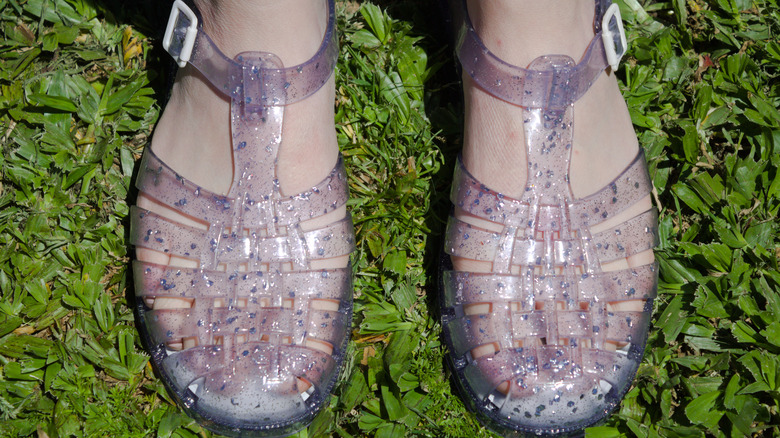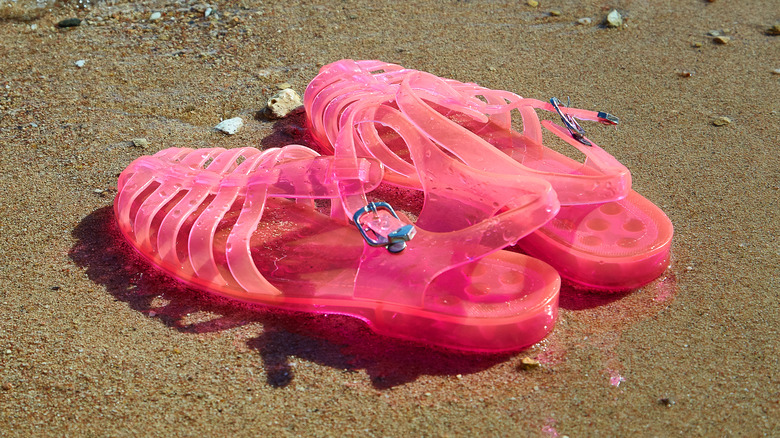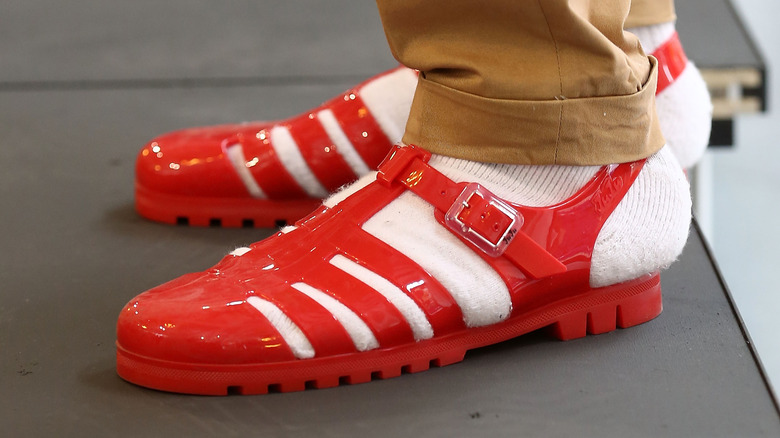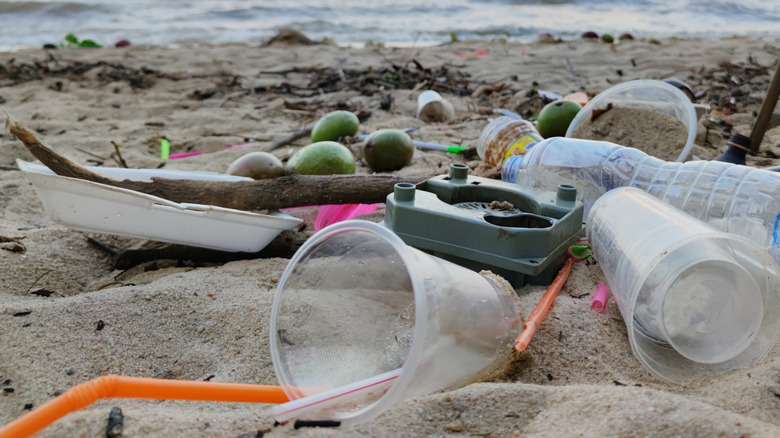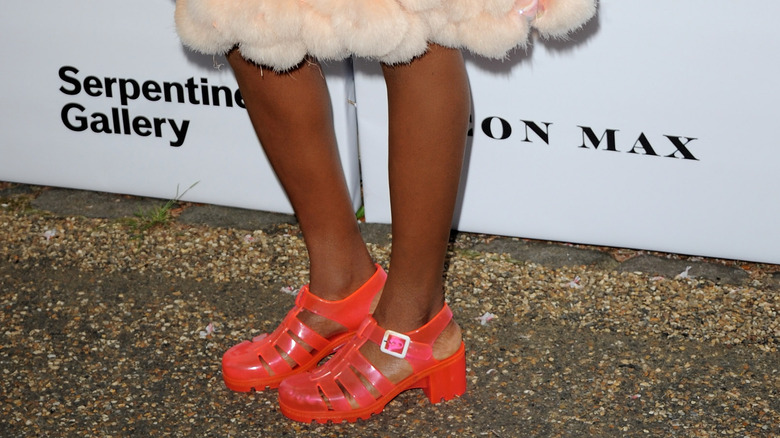What Happened To Jelly Sandals?
We may receive a commission on purchases made from links.
If you grew up in the 1980s or 1990s, then you probably remember jelly sandals. These bright, translucent, often sparkly shoes were once the height of playground fashion. But this rainbow footwear has a surprising origin — and an unexpected afterlife. Jellies are made from PVC plastic, according to the Harvey County Historical Museum. No one knows exactly when they first appeared. One theory is that they were invented in France in the aftermath of World War II by a shoemaker trying to compensate for a leather shortage, the Los Angeles Times reported.
However, Toronto Bata Shoe Museum curator Elizabeth Semmelhack says they probably emerged in the 1950s and 1960s as plastic became more popular. The shoes "were more likely a product of experimentation with industrial materials than a response to deprivation," she said. Jellies gained a foothold abroad before coming to the U.S. They were popular school shoes in Australia in the 1950s and 1960s, according to Sutori. But they would have to wait until the 1980s to make their U.S. debut.
Coming to America
There are two stories about how jellies first came to the U.S. According to one, they were first spotted by former bank president Preston Haag Sr. while on a trip to South America to find products to sell back home, Bustle reported. While in Brazil, Haag noticed women wearing bright, cheap plastic shoes and sourced them to a small local factory called Grendene. He decided to distribute them in the U.S. and first introduced them at the 1982 World's Fair in Knoxville, Tennessee. A year later, Bloomingdale's placed an order for 2,400 pairs in nine styles. Jellies were a hit.
However, Haag may not have actually been the first person to bring the sandals to the states. A 1980 New York Times article gives the credit to shoemaker Bert Geller. Geller first noticed the shoes on a trip to Greece. They were worn by workers and maids and typically came in practical blacks and browns. He redesigned them to be translucent and multi-colored and began selling them at Saks Fifth Avenue and Macy's for $22 for men's and $20 for women's. The New York Times interviewed shoppers to get their first impressions of the new shoes. One woman, who couldn't decide between a grape and blue pair, ended up buying both. "Perhaps I'll wear one of each and start a trend," she said.
From fashion to fun
Both Preston Haag Sr. and Bert Geller had something in common. They expected jellies to be high-fashion items. Haag Sr. named his subsidiary of the Brazilian Grendene factory "Grendha," and he had famous designers Thierry Mugler, Dorothee Bis, Jean-Paul Gaultier, and Fiorucci design some styles, according to the FIDM Museum. Grendha jellies from Bis, Mugler, and Gaultier were even advertised in Vogue in 1985. "The key has been keeping the shoe in high-fashion. We refuse to sell [the shoe] in discount stores. That would hurt the positive image we've built up," Haag told the Ocala Star-Banner the same year (via Bustle). Geller's shoes, meanwhile, were sold at Saks, with the average customer buying three pairs, according to FIDM. While most said they would use them for gardening or at the beach, one man bought a red pair to wear with a tuxedo at a fancy event.
The shoes' high-fashion status didn't last, however, Bustle explained. The plastic material was ultimately too hard to take seriously. Plus it gave awful blisters and retained foot odor. Their price fell and their low cost combined with the variety of colors made them popular with children and teenagers. "At less than $5 (oftentimes as little as $1), they were cheap enough to allow for a pair for each outfit in your closet!" one former '80s child recalled on Like Totally '80s. These are the jellies most of us remember and love.
Comeback kids
While jelly shoes went off the radar for a bit, The New York Times touted a comeback for the shoes as early as 2009. The second rise of the jelly was thanks to another shoe trend: Crocs. Debuting in 2002, these bright clogs made of resin were interpreted by many as an updated jelly. "Because of Crocs these molded plastic shoes are now widely accepted footwear, which makes it O.K. for designers to come out with their own styles," Marshal Cohen, chief industry analyst at market-research group NPD, told The New York Times.
With their comeback, jellies once again were a high-fashion item, but with a difference. Advances in plastics made it possible to shape the shoes better to the foot and to make shoes that were perfumed or odor resistant. The new models also caused less friction and sweat. Designers like Yves Saint Laurent, Givenchy, See by Chloé, and Tory Burch all added plastic shoes to their lines in 2009. By 2014, throwback jellies were popular in hipster neighborhoods, according to Bustle. They were both interpreted by high-end designers and sold at stores like American Apparel. In 2017, Elle reported black jellies with silver studs designed by Alberta Ferretti on the runway in Milan.
The problem with plastic
One major thing had changed between jellies' heyday in the 1980s and '90s and their reemergence in the aughts: attitudes toward plastic. In the last decade, there has been growing concern about plastic pollution and its impact on the environment. Greenpeace wrote that PVC, the material that jellies were traditionally made from, "is the single most environmentally damaging of all plastics." This has led some environmental groups to express concern about jellies. Natalie Fee, who founded an anti-plastic green group called City to Sea, told The Guardian that jellies "epitomize the folly of fashionistas."
Some shoemakers have taken these concerns to heart and designed more eco-friendly jellies. One example is Melissa, which is actually the designer brand of the Brazilian Grendha, according to The New York Times. In 2009, Melissa was already making 30% of its shoes from recycled PVC. By 2019, the company was making recyclable jellies and promised to install collection points at all their stores so that customers could easily turn in worn-out shoes, The Guardian reported. The UK-based company Juju also said it would make recyclable jellies.
Jellies today
Jellies are still around today in both the high-fashion and throwback varieties. InStyle declared that they were a trending item for the summer of 2021. British designer Alexa Chung partnered with Juju on floral jellies in May 2020. "I think the practical service jellies provide is what draws me to them," she told Vogue of her design. "Splash-proof footwear that is more appealing than a scuba sock." Gucci released a rubber slide sandal a year later, according to InStyle. In May of 2021, actress Blake Lively was photographed stepping out in jellies with husband Ryan Reynolds in May of 2021, InStyle reported at the time.
You don't have to be a fashionista or a celebrity to indulge your retro side with jellies, however. A simple Google search shows jelly platforms on sale for $44.95 from Nordstrom and jelly flats for as little as $8 on Amazon. Jellies may be made of plastic, but they are proof that, when it comes to trends, fashion knows how to recycle.
